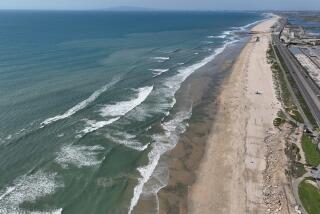How the 1969 Santa Barbara oil spill led to 50 years of coastal protections in California
Fifty years ago this week, a massive oil spill off the coast of Santa Barbara spewed an estimated 3 million gallons of crude oil into the ocean, creating an oil slick 35 miles long along California’s coast and killing thousands of birds, fish and sea mammals.
It sparked a coastal preservation act and marked a turning point in the state’s environmental movement.
Here is the story of the spill from the archives of The Times:
What happened?
The Jan. 28, 1969, blowout was caused by inadequate safety precautions taken by Unocal, which was known then as Union Oil. The company received a waiver from the U.S. Geological Survey that allowed it to build a protective casing around the drilling hole that was 61 feet short of the federal minimum requirements at the time.
The resulting explosion was so powerful it cracked the sea floor in five places, and crude oil spewed out of the rupture at a rate of 1,000 gallons an hour for a month before it could be slowed.
It was the worst oil spill in the nation’s history — until 20 years later, when the Exxon Valdez dumped 11 million gallons of crude off the coast of Alaska.
What was the impact?
Night after night, viewers were sickened by images of oil-drenched birds that couldn’t fly, sea otters that couldn’t swim and tides that brought in the corpses of dead seals and dolphins.
The spill even prompted a presidential visit to Santa Barbara, which suffered widespread damage to its sea grass and underwater flora. When newly sworn-in President Nixon saw the tarnished coastline, he remarked that the “incident has frankly touched the conscience of the American people.”
The cleanup was painstaking and slow. Oil was soaked up using straw and cat litter.
It took years for Santa Barbara’s ecosystem to recover.
How did the public and government respond?
After the 1969 spill, the California State Lands Commission placed a moratorium on all new offshore drilling in state waters, even on existing leases. A federal moratorium has effectively banned new offshore drilling in the federal waters off California for decades. Today, there are 23 offshore oil and gas leases in state waters, according to the commission.
New federal policies established after the disaster required offshore oil platform operators to pay unlimited amounts toward oil spill cleanup costs, along with penalties of up to $35 million.
In the aftermath of the spill, Nixon signed the National Environmental Policy Act in 1969, which requires environmental impact reports, and the California Environmental Quality Act was adopted the next year.
The nation’s first Earth Day, spearheaded by burgeoning grassroots environmental groups, was celebrated in 1970.
Laws regulating air and water pollution soon followed, as did legislation protecting sensitive coastal areas and endangered species.
More to Read
Sign up for Essential California
The most important California stories and recommendations in your inbox every morning.
You may occasionally receive promotional content from the Los Angeles Times.










